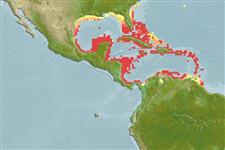>
Eupercaria/misc (Various families in series Eupercaria) >
Labridae (Wrasses) > Corinae
Etymology: Thalassoma: Greek, thalassa = the sea + Greek, soma = body; the colour of the sea (Ref. 45335).
More on author: Bloch.
Environment: milieu / climate zone / depth range / distribution range
Écologie
marin récifal; profondeur 0 - 40 m (Ref. 9710), usually 3 - 30 m (Ref. 27115). Tropical; 23°C - 26°C (Ref. 27115); 34°N - 7°N, 99°W - 58°W
Western Atlantic: Bermuda, Florida (USA), southeastern Gulf of Mexico and throughout the Caribbean Sea to northern South America.
Taille / Poids / Âge
Maturity: Lm ? range ? - ? cm
Max length : 25.0 cm TL mâle / non sexé; (Ref. 26340); âge max. reporté: 3.00 années (Ref. 3420)
Description synthétique
Morphologie | Morphométrie
Épines dorsales (Total): 8; Rayons mous dorsaux (Total): 12-13; Épines anales 3; Rayons mous anaux: 10 - 11. Body elongate; 3 primary color phases, the smallest with a black mid-lateral stripe which continues as pale red blotches on head; back above stripe yellow on reef fish and whitish on fish from inshore non-reef areas, and body below white. The largest phase, has a bright blue head and a green body with two broad vertical black bars anteriorly which are separated by a light blue interspace; this phase is always male. The small yellow phase with the black stripe may be either male or female (Ref. 13442).
Inhabits reef areas, inshore bays and seagrass beds. Feeds mainly on zooplankton and small benthic animals, but may also feed on ectoparasites of other fishes (Ref. 9626). Spawn at midday throughout the year (Ref. 26938). A protogynous hermaphrodite (Ref. 55367). Generally of no interest to fisheries because of its small average size (Ref. 5217).
Life cycle and mating behavior
Maturité | Reproduction | Frai | Œufs | Fécondité | Larves
A diandric species (Ref. 55367). Sex reversal is completed in more than 3-4 weeks (Ref. 34185, 34257). Length at sex change = 8.3 cm TL, forms leks during breeding (Ref. 55367).
Robins, C.R. and G.C. Ray, 1986. A field guide to Atlantic coast fishes of North America. Houghton Mifflin Company, Boston, U.S.A. 354 p. (Ref. 7251)
Statut dans la liste rouge de l'IUCN (Ref. 130435)
Menace pour l'homme
Harmless
Utilisations par l'homme
Aquarium: Commercial
Plus d'informations
RéférencesAquacultureProfil d'aquacultureSouchesGénétiqueElectrophoresesHéritabilitéPathologiesTraitementNutrientsMass conversion
Outils
Articles particuliers
Télécharger en XML
Sources Internet
Estimates based on models
Preferred temperature (Ref.
123201): 25 - 28.1, mean 26.8 °C (based on 222 cells).
Phylogenetic diversity index (Ref.
82804): PD
50 = 0.5000 [Uniqueness, from 0.5 = low to 2.0 = high].
Bayesian length-weight: a=0.00891 (0.00512 - 0.01553), b=3.02 (2.87 - 3.17), in cm total length, based on LWR estimates for this species & Genus-body shape (Ref.
93245).
Niveau trophique (Ref.
69278): 3.3 ±0.1 se; based on diet studies.
Generation time: 1.5 ( na - na) years. Estimated as median ln(3)/K based on 1
growth studies.
Résilience (Ref.
120179): Haut, temps minimum de doublement de population inférieur à 15 mois (k=0.7; tmax=3).
Fishing Vulnerability (Ref.
59153): Low vulnerability (20 of 100).
Nutrients (Ref.
124155): Calcium = 75.2 [45.5, 123.9] mg/100g; Iron = 0.761 [0.447, 1.351] mg/100g; Protein = 18.6 [15.8, 20.8] %; Omega3 = 0.149 [0.100, 0.227] g/100g; Selenium = 32 [20, 56] μg/100g; VitaminA = 77.7 [25.7, 279.6] μg/100g; Zinc = 1.51 [1.07, 2.36] mg/100g (wet weight);
